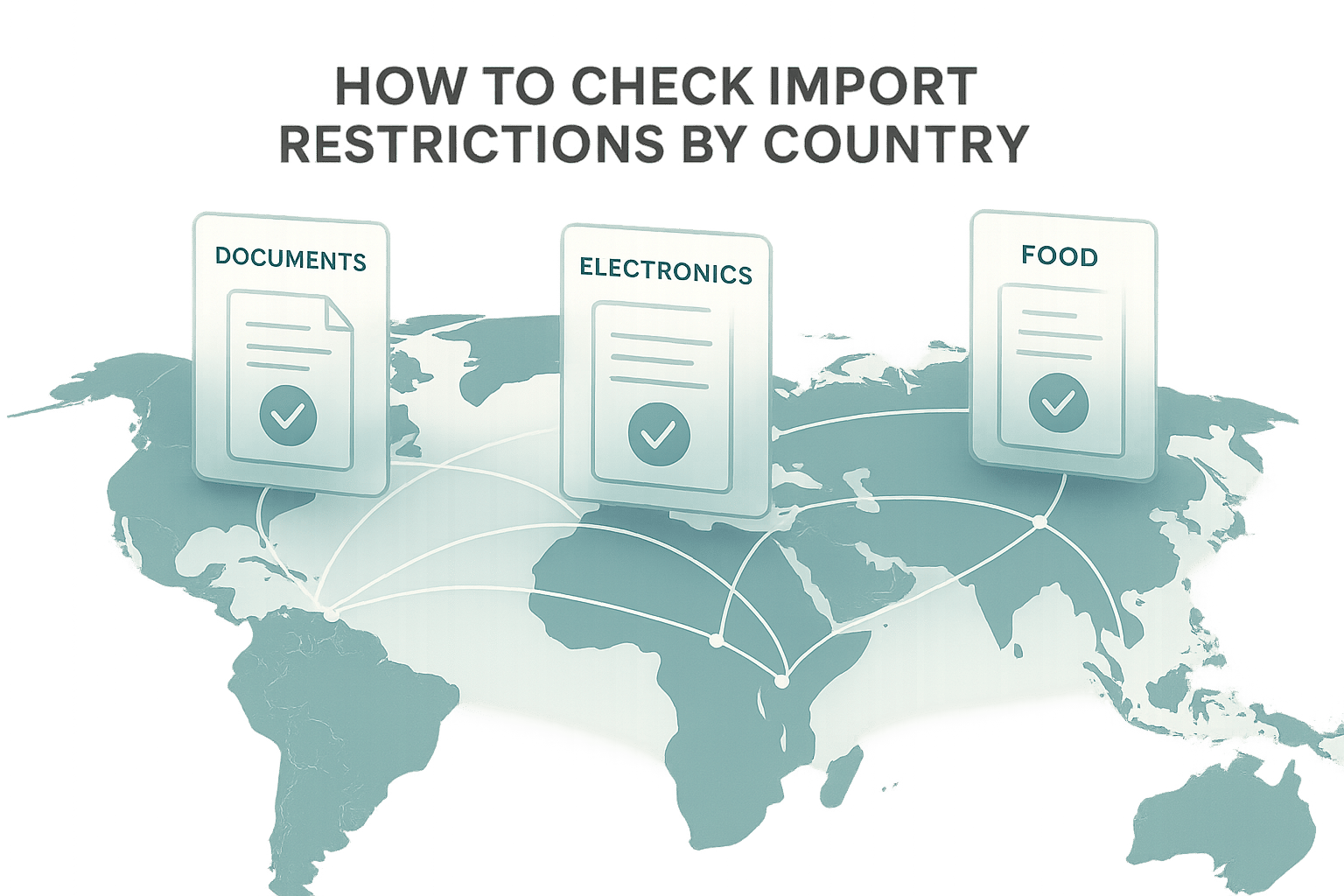In international trade, both commercial invoices and packing lists are essential for smooth customs clearance and efficient shipment handling. While the commercial invoice serves as a financial record for calculating duties and taxes, the packing list provides physical details about the shipment's contents. Both documents must align perfectly to avoid delays, penalties, or shipment holds. Here's what you need to know:
- Commercial Invoice: Includes pricing, payment terms, declared values, HS codes, and other financial details for customs and tax purposes.
- Packing List: Focuses on the shipment's physical details like item quantities, weights, dimensions, and packaging specifics.
Why Both Documents Matter:
- Customs Clearance: Customs officials use the invoice for duty calculations and the packing list for physical verification.
- Complex Shipments: For shipments with multiple items or packages, both documents ensure accurate classification and handling.
- High-Value or Regulated Goods: Accurate documentation is critical for sensitive, high-value, or regulated products.
Key Tip:
Ensure consistency between the two documents - mismatched details like weights or item descriptions can lead to costly delays. Use digital tools and standardized templates to minimize errors and streamline your documentation process.
How to write Invoice & Packing List for Exporting cargo? We make a Template for beginners of Trading
Commercial Invoice vs. Packing List: What Each Document Does
Understanding the roles of the commercial invoice and packing list is essential for smooth international trade. These documents serve different purposes, and knowing where each type of information belongs ensures accurate documentation and hassle-free customs clearance.
Commercial Invoice Basics
The commercial invoice is both a bill of sale and a customs declaration. It confirms the legitimacy of the transaction and provides critical details for calculating duties and taxes.
Key details included in a commercial invoice are:
- Seller and buyer contact information
- Item descriptions and quantities
- Declared values in U.S. dollars
- Terms of sale (e.g., FOB or CIF)
- Payment terms
- Country of origin
- Total weight and dimensions
- HS codes (Harmonized System codes)
The declared values are particularly important because customs authorities use them to calculate duties. Any discrepancies in this information could lead to inspections and delays.
Packing List Basics
The packing list is all about the shipment's physical details and logistics. It lists the exact quantities, weights, and dimensions of the items being shipped. Unlike the commercial invoice, it doesn’t include pricing information. Instead, it focuses on how the items are packed and the total number of packages.
This document is crucial during inspections. It helps customs officials locate specific items quickly and resolve any disputes over missing or damaged goods.
Side-by-Side Comparison: Commercial Invoice vs. Packing List
| Feature | Commercial Invoice | Packing List |
|---|---|---|
| Primary Purpose | Financial record and customs duty assessment | Physical inventory and logistical verification |
| Key Information | Pricing, payment terms, total transaction value, HS codes | Item quantities, package contents, weights, dimensions |
| Regulatory Focus | Tax and duty calculations, legal proof of sale | Physical verification and cargo handling |
| Required by Law | Mandatory for international shipments | Essential for customs clearance and compliance |
| Currency Details | Declared values in USD | No pricing or currency information |
Together, these documents create a complete picture of the shipment. Customs officials rely on the commercial invoice for financial and legal details, while the packing list ensures logistical accuracy and smooth handling of the cargo. Both are indispensable for preventing errors, avoiding fraud, and expediting the customs process.
When You Need Both Documents
For most international shipments, having both a commercial invoice and a packing list is not just helpful - it’s often mandatory. These documents work hand in hand to meet regulatory requirements and keep shipments moving without unnecessary delays.
Customs Clearance Requirements
Agencies like U.S. Customs and Border Protection (CBP) and international customs offices typically require both a commercial invoice and a packing list for customs clearance. Here's why: the invoice is used to verify duty calculations, while the packing list provides details about the shipment's contents. Customs officials cross-check the declared values and quantities against the actual goods. If there’s a mismatch, it could lead to further inspections and delays. Together, these documents ensure shipments are processed efficiently and in compliance with regulations.
Complex Shipments with Multiple Items or Packages
When dealing with shipments that include multiple packages, a mix of product types, or consolidated orders from various suppliers, both documents become even more critical. The commercial invoice gives an overview of the shipment's total value and quantity, while the packing list breaks down the contents of each package. This level of detail is crucial if customs officials need to inspect specific items or if damage occurs to particular packages during transit. For consolidated shipments from different suppliers, these documents help customs accurately classify goods and determine the appropriate duty rates for each item.
High-Value or Regulated Goods
For high-value items like electronics, luxury goods, or medical devices - and regulated products such as pharmaceuticals, food, or chemicals - accurate documentation is non-negotiable. The commercial invoice provides the valuation and classification needed for customs, while the packing list offers precise product details and confirms the shipment's origin. These documents are especially important for ensuring compliance with regulations and speeding up customs processing for such sensitive shipments.
sbb-itb-633367f
How These Documents Work Together
Commercial invoices and packing lists work hand in hand to provide customs and logistics providers with all the details they need for smooth processing. To make this partnership effective, keeping the data consistent across both documents is absolutely critical.
Keeping Information Consistent Between Documents
Key details like item descriptions, quantities, weights, and package counts must match perfectly between the commercial invoice and the packing list. Even small inconsistencies - like slightly different item descriptions - can raise red flags with customs. For example, if the invoice lists 500 lbs as the total gross weight, the packing list should add up to the same amount. Any mismatch, whether in declared quantities or package counts, can lead to delays and complications.
How Officials Verify Shipments Using Both Documents
Customs officials rely on these two documents to cross-check and verify shipment details. They ensure that the item descriptions, quantities, and weights align perfectly. This process minimizes errors and ensures the shipment moves through the system without unnecessary holdups.
Problems Caused by Mismatched Information
When the information on these documents doesn’t match, it can result in shipment delays, financial penalties, or even shipment holds. Worse, repeated errors can lead to increased scrutiny on future shipments, causing longer processing times and more frequent inspections. These issues not only slow down operations but can also damage trust with customs and other stakeholders.
Best Practices for Managing Both Documents
Accurate commercial invoices and packing lists are key to avoiding costly customs errors. By setting up systematic processes, you can catch mistakes before they ever reach customs officials.
How to Keep Details Consistent
Start by preparing the commercial invoice first, then use it as the foundation for your packing list. This approach ensures consistency in product descriptions, quantities, and weights. For example, if your invoice lists 250 wireless headphones with a total weight of 125 lbs, your packing list must reflect those exact numbers.
Consistency in product descriptions is especially critical. If your invoice describes an item as "Bluetooth Wireless Headphones - Model XH-200", don’t simplify it to "Wireless Headphones" on the packing list. Even minor differences can cause customs delays.
To ensure accuracy, implement a cross-checking system. Have one person prepare the documents and another review them for alignment. This two-person review process often catches errors that a single reviewer might overlook.
For even better results, you can turn to digital tools.
Using Digital Tools for Better Accuracy
Digital platforms can significantly reduce errors by providing standardized product data from the start. For instance, tools like ForthSource aggregate detailed supplier information, including accurate product specifications and packaging details. This centralized data eliminates the need for manual transcription, reducing the risk of typos and mismatches that could lead to customs issues.
You can also use spreadsheet templates to streamline your documentation process. These templates can automatically calculate totals and flag inconsistencies. For example, if the quantities on your invoice and packing list don’t match, the template will highlight the discrepancy immediately, saving you time and preventing errors.
Creating a Documentation Checklist
Once you’ve ensured consistency with manual checks and digital tools, finalize your process with a standardized checklist. This checklist should confirm that:
- Product descriptions match exactly between documents.
- Quantities are perfectly aligned.
- Weights are calculated consistently.
Don’t forget to include steps for verifying regulatory requirements specific to your products. For example, electronics shipments often require different documentation than textiles or food products. Incorporate these industry-specific needs into your standard workflow to avoid missing key details during hectic shipping periods.
Finally, build in enough review time to catch errors before they become problems. Train team members to handle documentation accurately, even during staffing shortages. Clear, written processes ensure that anyone on your team can step in and maintain the same high standards.
Conclusion: Getting Documentation Right for Smooth Trade
Getting your commercial invoices and packing lists right is more than just a formality - it's the key to avoiding delays and penalties in international trade. These documents allow customs officials to verify shipments quickly and efficiently.
Did you know that around 25% of international shipments face delays due to incorrect or incomplete shipping documents, such as commercial invoices? Even more striking, over 30% of customs clearance delays stem from incorrect HS codes. And those delays aren’t just inconvenient - they can increase import costs by 1–2%.
This highlights why a well-organized documentation process is so crucial. Think of your commercial invoice and packing list as two sides of the same coin. The invoice outlines the financial details customs officers need for duty calculations, while the packing list provides the physical specifics - like product descriptions, quantities, and weights. When these documents align perfectly, customs clearance becomes much smoother and faster.
Accurate documentation doesn’t just save time - it saves money. A precise, well-prepared commercial invoice paired with a consistent packing list can reduce clearance times significantly. Faster clearance means your products get to your customers quicker, keeping cash flow steady and business relationships strong.
"Any discrepancies between these documents and the actual shipment can lead to significant consequences. Delays at Customs or even penalties may occur due to inaccurate information." – connecta-network.com
To maintain this level of accuracy, rely on proven methods and modern tools. Start with standardized templates and consider using digital platforms like ForthSource. These tools help integrate accurate product data directly into your documents, reducing errors and preventing costly issues like customs delays, penalties, or even seized shipments.
As trade evolves with technologies like AI-driven verification systems and blockchain for document security, mastering your documentation process today sets your business up for future success. In short, consistent, accurate, and complete documentation isn’t just a best practice - it’s your ticket to smoother international trade.
FAQs
What happens if the commercial invoice and packing list don’t match?
Discrepancies between a commercial invoice and a packing list can create serious headaches in international trade. These mismatches might trigger customs clearance delays, extra inspections, or even penalties. In some situations, they could lead to higher customs fees or damage business relationships, throwing the entire shipping process off track.
To steer clear of these issues, it’s crucial to double-check that both documents are accurate and aligned. They’re essential for ensuring smooth customs procedures and preserving trust with your trade partners.
How can digital tools help ensure accurate commercial invoices and packing lists in international trade?
Digital tools play a key role in improving the accuracy of commercial invoices and packing lists. By automating data entry and validation, they minimize manual errors and ensure consistency across all documents. Additionally, these tools can cross-check information against compliance standards, reducing the risk of discrepancies that might otherwise delay customs clearance.
This streamlined approach not only saves time but also enhances the reliability of trade documentation. As a result, international trade becomes more efficient and less burdensome for businesses.
Why do you need both a commercial invoice and a packing list for high-value or regulated goods?
When shipping high-value or regulated goods, having both a commercial invoice and a packing list is crucial because these documents serve distinct yet complementary roles in international trade.
The commercial invoice provides key transaction details like the item's value, its origin, and payment terms. These details are critical for customs clearance and determining duties or taxes.
Meanwhile, the packing list offers a precise breakdown of the shipment, including quantities, dimensions, and weight of the items. This document helps customs officials verify the cargo, confirm accuracy, and streamline inspections - especially for goods subject to regulation.
By working together, these documents help prevent delays, fines, and compliance problems, making the shipping process much smoother.


